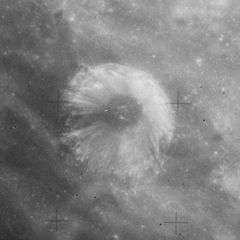Glaisher (crater)
|
Apollo 15 mapping camera image | |
| Coordinates | 13°12′N 49°30′E / 13.2°N 49.5°ECoordinates: 13°12′N 49°30′E / 13.2°N 49.5°E |
|---|---|
| Diameter | 16 km |
| Depth | 2.0 km |
| Colongitude | 311° at sunrise |
| Eponym | James Glaisher |

Glaisher is a lunar impact crater that is located in the region of terrain that forms the southwest border of Mare Crisium. It lies to the southwest of the lava-flooded crater Yerkes, and west-northwest of the Greaves–Lick crater pair. It is surrounded by a ring of satellite craters of various dimensions, the larger companions generally being arranged to the south of Glaisher.
This crater is circular, with a bowl-shaped interior and a small floor at the midpoint. The crater has not been significantly worn by subsequent impacts. A merged, double-crater formation is attached to its southern rim, consisting of Glaisher E at the northwest end and Glaisher G to the southeast.
The crater was named after James Glaisher and its name was approved by the IAU in 1935.[1]
Satellite craters
By convention these features are identified on lunar maps by placing the letter on the side of the crater midpoint that is closest to Glaisher.
| Glaisher | Latitude | Longitude | Diameter |
|---|---|---|---|
| A | 12.9° N | 50.7° E | 19 km |
| B | 12.6° N | 50.1° E | 18 km |
| E | 12.7° N | 49.2° E | 21 km |
| F | 13.7° N | 50.0° E | 7 km |
| G | 12.4° N | 49.5° E | 20 km |
| H | 13.8° N | 49.6° E | 5 km |
| L | 13.4° N | 48.8° E | 7 km |
| M | 13.1° N | 48.6° E | 5 km |
| N | 13.1° N | 47.5° E | 7 km |
| V | 11.1° N | 49.9° E | 12 km |
| W | 12.4° N | 47.6° E | 46 km |
References
- ↑ Glaisher crater, Gazetteer of Planetary Nomenclature, International Astronomical Union (IAU) Working Group for Planetary System Nomenclature (WGPSN), retrieved June 2015
- Andersson, L. E.; Whitaker, E. A. (1982). NASA Catalogue of Lunar Nomenclature. NASA RP-1097.
- Blue, Jennifer (July 25, 2007). "Gazetteer of Planetary Nomenclature". USGS. Retrieved 2007-08-05.
- Bussey, B.; Spudis, P. (2004). The Clementine Atlas of the Moon. New York: Cambridge University Press. ISBN 978-0-521-81528-4.
- Cocks, Elijah E.; Cocks, Josiah C. (1995). Who's Who on the Moon: A Biographical Dictionary of Lunar Nomenclature. Tudor Publishers. ISBN 978-0-936389-27-1.
- McDowell, Jonathan (July 15, 2007). "Lunar Nomenclature". Jonathan's Space Report. Retrieved 2007-10-24.
- Menzel, D. H.; Minnaert, M.; Levin, B.; Dollfus, A.; Bell, B. (1971). "Report on Lunar Nomenclature by the Working Group of Commission 17 of the IAU". Space Science Reviews. 12 (2): 136–186. Bibcode:1971SSRv...12..136M. doi:10.1007/BF00171763.
- Moore, Patrick (2001). On the Moon. Sterling Publishing Co. ISBN 978-0-304-35469-6.
- Price, Fred W. (1988). The Moon Observer's Handbook. Cambridge University Press. ISBN 978-0-521-33500-3.
- Rükl, Antonín (1990). Atlas of the Moon. Kalmbach Books. ISBN 978-0-913135-17-4.
- Webb, Rev. T. W. (1962). Celestial Objects for Common Telescopes (6th revised ed.). Dover. ISBN 978-0-486-20917-3.
- Whitaker, Ewen A. (1999). Mapping and Naming the Moon. Cambridge University Press. ISBN 978-0-521-62248-6.
- Wlasuk, Peter T. (2000). Observing the Moon. Springer. ISBN 978-1-85233-193-1.
External links
- LTO-61B2 Glaisher, Lunar Topographic Orthophotomap (LTO) Series
